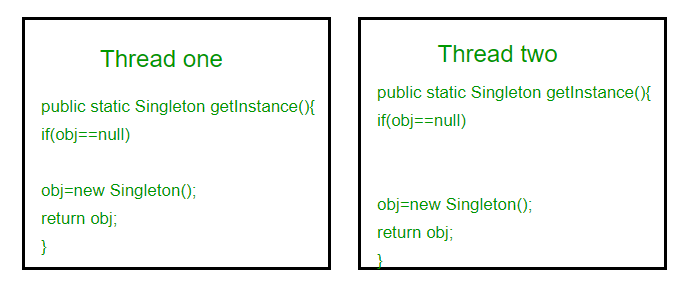The singleton pattern is one of the simplest design patterns. Sometimes we need to have only one instance of our class for example a single DB connection shared by multiple objects as creating a separate DB connection for every object may be costly. Similarly, there can be a single configuration manager or error manager in an application that handles all problems instead of creating multiple managers. The singleton pattern is a design pattern that restricts the instantiation of a class to one object. Let’s see various design options for implementing such a class. If you have a good handle on static class variables and access modifiers this should not be a difficult task.
Method 1: Classic Implementation
Java
class Singleton
{
private static Singleton obj;
private Singleton() {}
public static Singleton getInstance()
{
if (obj==null)
obj = new Singleton();
return obj;
}
}
|
Here we have declared getInstance() static so that we can call it without instantiating the class. The first time getInstance() is called it creates a new singleton object and after that, it just returns the same object. Note that Singleton obj is not created until we need it and call the getInstance() method. This is called lazy instantiation. The main problem with the above method is that it is not thread-safe. Consider the following execution sequence.

This execution sequence creates two objects for the singleton. Therefore this classic implementation is not thread-safe.
Method 2: Make getInstance() synchronized
Java
class Singleton
{
private static Singleton obj;
private Singleton() {}
public static synchronized Singleton getInstance()
{
if (obj==null)
obj = new Singleton();
return obj;
}
}
|
Here using synchronized makes sure that only one thread at a time can execute getInstance(). The main disadvantage of this method is that using synchronized every time while creating the singleton object is expensive and may decrease the performance of your program. However, if the performance of getInstance() is not critical for your application this method provides a clean and simple solution.
Method 3: Eager Instantiation
Java
class Singleton
{
private static Singleton obj = new Singleton();
private Singleton() {}
public static Singleton getInstance()
{
return obj;
}
}
|
Here we have created an instance of a singleton in a static initializer. JVM executes a static initializer when the class is loaded and hence this is guaranteed to be thread-safe. Use this method only when your singleton class is light and is used throughout the execution of your program.
Method 4 (Best): Use “Double Checked Locking”
If you notice carefully once an object is created synchronization is no longer useful because now obj will not be null and any sequence of operations will lead to consistent results. So we will only acquire the lock on the getInstance() once when the obj is null. This way we only synchronize the first way through, just what we want.
Java
class Singleton
{
private static volatile Singleton obj = null;
private Singleton() {}
public static Singleton getInstance()
{
if (obj == null)
{
synchronized (Singleton.class)
{
if (obj==null)
obj = new Singleton();
}
}
return obj;
}
}
|
We have declared the obj volatile which ensures that multiple threads offer the obj variable correctly when it is being initialized to the Singleton instance. This method drastically reduces the overhead of calling the synchronized method every time.
Whether you're preparing for your first job interview or aiming to upskill in this ever-evolving tech landscape,
GeeksforGeeks Courses are your key to success. We provide top-quality content at affordable prices, all geared towards accelerating your growth in a time-bound manner. Join the millions we've already empowered, and we're here to do the same for you. Don't miss out -
check it out now!